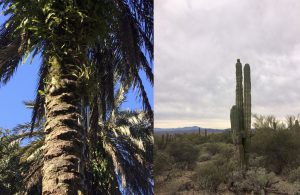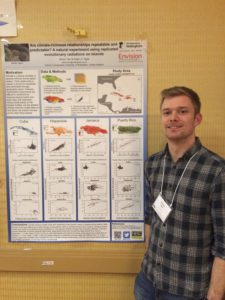
March 16, 2017, by lzzeb
Conferences, Cold and Cacti
A blog by Dr Adam Algar
The biennial meeting of the International Biogeography Society has become a January tradition that has taken me to the Canary Islands, Crete, Florida, and Germany. The 2017 meeting was originally scheduled for Salvador, Brazil. However, in 2016, it was announced that the meeting was being moved to Tucson, Arizona (USA) because of concerns over the prevalence of Zika virus. The Society had to make a very tough decision but I think it was the right one. And getting a chance to experience the deserts of the Southwestern USA helped ease the pain of missing out on birding and herping (reptile watching) in the Amazon. Plus, the move to Arizona meant that this year’s trip to the IBS meeting would have a pre-conference bonus. Coincidentally, the Society for Comparative and Integrative Biology’s (SICB) annual meeting was in New Orleans, immediately before the IBS meeting. As I was heading stateside anyway, with the support of an international travel grant from the School of Geography, it made sense to double up and squeeze in both conferences. Plus, one of my PhD students, James Hicks, was presenting his work on effects of oil palm plantations on Malaysian lizards at SICB, so I could do SICB with him before heading to Arizona to meet up with another PhD Student, Simon Tarr, and the rest of the Nottingham contingent (Richard Field, Catherine Waite and Joe Bailey) at IBS.
In addition to seeing/presenting interesting science and networking, conferences are also great places to find inspiration for your own research. This prospect was what particularly excited me about dovetailing SICB and IBS. Research at both conferences would focus on fundamental questions of how evolution works and how species are being affected by rapid climate and land use change, but at very different scales and with very different tools. At the IBS meeting, the focus would be on biogeography and macroecology: the study of global ecological and evolutionary patterns using statistical modelling and ‘big data’. In contrast, at SICB, research would focus on organismal scales, asking how individual animals (and plants) behave, function, interact and adapt, mostly using field and laboratory experimentation. What really fascinates me as an ecologist is how the actions of individual organisms—what to eat, where to live and who to mate with—can produce striking emergent patterns in the distribution of biodiversity across the globe. In other words, all the patterns that we would be talking about and trying to explain at IBS must arise from the ecological and evolutionary processes being studied at SICB. My hope was that by experience both approaches to ecology in such proximity would produce an abundance of inspiration and new insights (spoiler alert: it did!).
As it turned out, SICB was even better than I’d hoped. In addition to catching up with a few old friends and lab-mates from my post-doc days, and sharing some great (but very fried) New Orleans food, the sheer volume of fascinating and high-quality biology being presented was staggering. Most of the talks James and I sought out were those centred around lizard thermal ecology, of which there were many. How rising temperatures will affect ectotherms (‘cold-blooded’ animals) like reptiles has become a key research focus for ecologists (including me) over the past 10 years. This theme continued at the meeting, but it was very interesting to see the new angles current research is taking. There was a lot of focus placed on land use change, rather than just climate change, particularly urbanization. A few talks especially stood out. Shane Campbell-Staton, a fellow Losos-lab alum, showed that heat tolerance in Anolis lizards is sensitive to acclimation conditions, which elicited a few gasps of surprise from the audience (including me), since until now we’ve thought this key trait was relatively insensitive to acclimation temperatures. Jeanine Refsnider’s, from the University of Toledo, talk also piqued my interest. They used a translocation experiment to measure the ability of lizards to alter their thermoregulatory behaviour in novel thermal environments. This work used tiny light sensors, originally created to track migrating birds, to record, in real time, shade and sun use by these lizards, which was just amazing. Finally, a talk on the biomechanics of mantis shrimp was memorable not just because these are really cool creatures, but because the speaker, Dr. Martha Muñoz, is a good friend and we wrote a couple of papers together when she was a PhD student and I was a post-doc. It was interesting to see the direction of her recent work has gone, but also to celebrate her recent faculty position at Virginia Tech University. A final highlight was seeing my PhD student, James, present his work on land cover change and dragon lizards in Malaysia. This was the first time I’d see one of my students presenting at a big international conference and while James seemed calm and relaxed, I was nervous enough for both of us!
Unsurprisingly, James did great and there were a few very insightful questions from the audience that have spurred some new ways of thinking about selection pressures on organisms in tropical plantations. A major bonus of the meeting was the chance, in between lizard ecology talks, to learn about topics and species that I know nothing about, and that I will never work on, but which are just plain cool. Moreover, the sheer enthusiasm all presenters had for their study organisms was infectious, and a reminder of just how wild, weird and wonderful, evolution really is. For example, check out this GIF, based on work presented by grad student Grace Freymiller from the Univeristy of San Diego, of a night-vision super slow motion video of how a kangaroo rat escapes rattlesnake strikes. Awesome.
The second leg of my journey meant leaving a surprisingly cold New Orleans (icicles on palm trees!) for the Arizona desert, the IBS meeting, and (thankfully) comfortably warm days. One of my favourite things about IBS meetings is the field trips. They’re a chance to experience the biodiversity and landscapes of a new area, in this case Arizona’s Sonora Desert, before delving into the depths of a conference centre for a few days. This year we headed to the Sonoran Desert Museum, a botanical and zoological garden showcasing the region’s flora and fauna. It was fantastic! Unfortunately, it was too cloudy for any of the lizards to be active (it was winter after all), but this was more than compensated for by the birds. The great thing about being in a new biome is that almost all the species are lifers (not that I’m counting) and armed with my Christmas gift of new binoculars (thanks Leslie!), we saw a dozen or so species that were all new to me including: black throated sparrow, cactus wren, curve billed thrasher, black-tailed gnatcatcher, gila woodpecker, verdin, Abert’s towhee, ladder-backed woodpecker, painopepla, pyrhhuloxia, and a canyon towhee. Oh, and a house sparrow. Of course.

From SICB to IBS. A palm tree festooned with icicles in a surprisingly cold New Orleans and the iconic Saguaro cactus of the Sonoran Desert
I’ve been attending IBS meetings for a decade, and although each has their own charms and quirks, there’s a comfortable rhythm to them with the pre-conference social which is a chance to meet up with colleagues and friends (you’ll sense a theme here – the conversations and connections that you make during the social periods at conferences can produce more productive ideas than the formal scientific sessions), before the scientific programme starts the next day. It was an interesting shift from the very organism focused talks at SICB to the statistical driven approaches at IBS, yet none the less fascinating. Fortunately, my talk was early in the programme, which meant I didn’t spend all the breaks at the meeting frantically putting slides together! As with SICB, a few key talks really stood out. Sal Keith, who has recently joined Lancaster University, gave a thought provoking talk on the role of animal behaviour in shaping biogeographical patterns, Petr Keil from iDiv in Germany spoke about the predictability of extinction, and there was a fascinating talk on climate niche dynamics (of lizards of course!) by Maria Strangas, a PhD student at City University of New York. Nottingham has well represented with a poster by my student Simon Tarr on using islands as natural experiments to test the repeatability of climate-biodiversity relationships, as well as presentations/posters by PhD students Joe Bailey and Catherine Waite, with Richard Field also in attendance running between Society and Editorial Board meetings.
An extra bonus was the chance meeting of former and current students and post-docs of my erstwhile PhD supervisor, Jeremy Kerr, at the University of Ottawa. All in all, it was a great meeting, capped off by a Wallace Award talk by an absolute legend of biogeography, Margaret Davis.
As I’d hoped, the SICB-IBS doubleheader was a definite success, with many new unexpected discoveries (Dallas’s airport has amazing breakfast bagels!). As I’d hoped the different foci of the two conferences, one on organisms, the other on global patterns gave an interesting dual perspective on the ecology and evolution of life in a rapidly changing world, and I returned to the UK with a host of new ideas to explore, some nascent scientific collaborations, and a few new bird species for the life list. What could be better?
No comments yet, fill out a comment to be the first



Leave a Reply